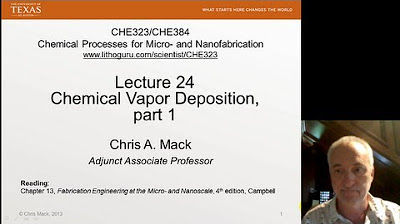Lecture 25 (CHE 323) CVD, part 2
Summary
TLDRThis lecture discusses chemical vapor deposition (CVD) processes, focusing on how temperature affects deposition rates. It explains the transition between reaction-controlled and diffusion-controlled regimes and their impact on CVD chamber design. The lecture also explores the influence of pressure on deposition rates and compares atmospheric CVD, LPCVD, and PECVD processes, highlighting their advantages and disadvantages for different applications in micro and nanofabrication.
Takeaways
- 🔬 Chemical Vapor Deposition (CVD) involves two main regimes: reaction control and diffusion control, which dictate the design of the CVD chamber.
- 🌡️ In the reaction control regime, the rate of deposition is sensitive to temperature, necessitating precise temperature control for uniform film thickness.
- 💨 In the diffusion control regime, the deposition rate is influenced by gas flow, emphasizing the need for consistent gas distribution across the wafer.
- 🔥 High activation energy in the reaction control regime allows for significant changes in deposition rate with temperature adjustments.
- 📉 At high temperatures, the transition to the diffusion control regime is marked by a leveling off of the deposition rate due to weaker temperature dependence.
- 🧱 Hot wall systems are used in reaction control regime CVD, maintaining uniform temperature across the chamber to ensure consistent deposition.
- 🏞️ Cold wall systems are preferred in diffusion control regime CVD, as they prevent deposition on chamber walls, reducing the need for frequent cleaning.
- 📉 Lowering the pressure in a CVD system can increase the mass transfer coefficient and deposition rate, especially in the diffusion control regime.
- 🌀 The orientation and layout of wafers in the chamber differ between regimes, with vertical stacking in hot wall systems and flat placement on a susceptor in cold wall systems.
- 🔑 The total pressure in a CVD system can be adjusted without changing the partial pressure of reactants, which affects the diffusivity and deposition rate.
- 💡 Plasma Enhanced CVD (PECVD) is used for low-temperature deposition processes where high temperatures would cause damage to the substrate or previously deposited layers.
Q & A
What is the main focus of Lecture 25 in the Chemical Processes for Micro and Nanofabrication course?
-Lecture 25 focuses on the second part of the two-part series on Chemical Vapor Deposition (CVD), discussing the impact of temperature and pressure on deposition rate and the different regimes of CVD processes.
Who is the professor delivering the lecture?
-The professor delivering the lecture is Chris Mack.
What is the relationship between deposition rate and temperature in CVD?
-The deposition rate in CVD is related to temperature through a pseudo-Arrhenius plot, where the log of the deposition rate is plotted against the reciprocal of temperature.
What are the two parameters that determine the overall rate constant in CVD?
-The two parameters that determine the overall rate constant in CVD are the surface reaction rate constant (k_s) and the mass transport coefficient (H_G).
What are the two different regimes in CVD processes?
-The two different regimes in CVD processes are the reaction control regime and the diffusion control regime.
How does the reaction control regime differ from the diffusion control regime?
-In the reaction control regime, the deposition rate is limited by the reaction at the wafer surface, with a high activation energy and sensitive to temperature changes. In the diffusion control regime, the rate is limited by the mass transfer coefficient, with a lower temperature dependence.
Why is temperature uniformity important in the reaction control regime?
-Temperature uniformity is crucial in the reaction control regime because small changes in temperature can lead to significant changes in deposition rate, affecting the thickness uniformity of the final film.
What is the significance of the hot wall system in CVD?
-A hot wall system in CVD is used to maintain thermal equilibrium and uniform temperature across the chamber, which is essential for good temperature control and deposition uniformity in the reaction control regime.
How does pressure affect the deposition rate in CVD?
-Pressure affects the deposition rate by influencing the diffusivity of the reactants and the boundary layer thickness. Lowering the pressure can increase the mass transfer coefficient and deposition rate in the diffusion control regime.
What are the advantages and disadvantages of atmospheric CVD compared to LPCVD?
-Atmospheric CVD can provide higher deposition rates but requires operation in the diffusion control regime, which is less uniform. LPCVD, on the other hand, operates at lower pressures and allows for operation in the reaction control regime, leading to better film uniformity but at lower deposition rates.
What is PECVD and how does it differ from traditional CVD?
-PECVD, or Plasma Enhanced CVD, is a variation of traditional CVD where an RF plasma is used to ionize reactants, increasing reaction rates and deposition rates at lower temperatures. It offers better step coverage and via filling but typically has lower throughput compared to LPCVD.
Why might one choose to use PECVD over LPCVD?
-One might choose to use PECVD over LPCVD when high temperatures are not tolerable for the substrate, such as when depositing on top of aluminum, to prevent material diffusion and maintain reliability.
Outlines

このセクションは有料ユーザー限定です。 アクセスするには、アップグレードをお願いします。
今すぐアップグレードMindmap

このセクションは有料ユーザー限定です。 アクセスするには、アップグレードをお願いします。
今すぐアップグレードKeywords

このセクションは有料ユーザー限定です。 アクセスするには、アップグレードをお願いします。
今すぐアップグレードHighlights

このセクションは有料ユーザー限定です。 アクセスするには、アップグレードをお願いします。
今すぐアップグレードTranscripts

このセクションは有料ユーザー限定です。 アクセスするには、アップグレードをお願いします。
今すぐアップグレード関連動画をさらに表示

Lecture 24 (CHE 323) CVD, part 1

Physical Vapour Deposition - Detailed Explanation

Chemical Vapor Deposition: Basic Function - Nanotechnology: A Maker’s Course

Exogenic Processes | Earth Science | TagLish Video Lesson

WEATHERING, EROSION AND DEPOSITION (EXOGENIC PROCESS) / EARTH AND LIFE SCIENCE / SCIENCE 11 - MELC 5

Phase Changes, Heats of Fusion and Vaporization, and Phase Diagrams
5.0 / 5 (0 votes)
